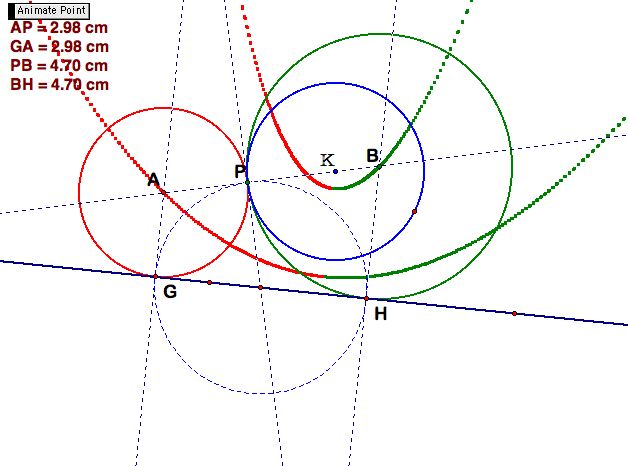

One interesting problem concerning circles is how to construct a circle tangent to two given circles. It turns out that there are several ways to approach this problem and several results that connect to conic sections.
The first situation I looked at had to do with one circle completely in the interior of another circle. In this case, there were two ways in which to construct the tangent circle. One that appeared to be between the two circles (left), and another that appeared to enclose the inner circle (right).
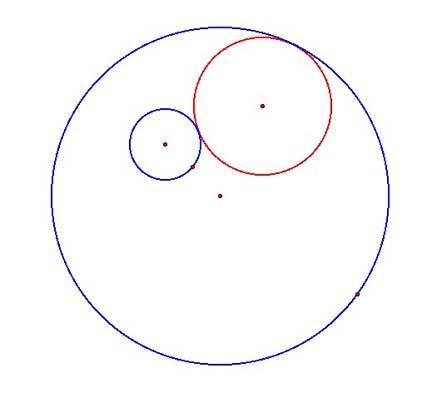 |
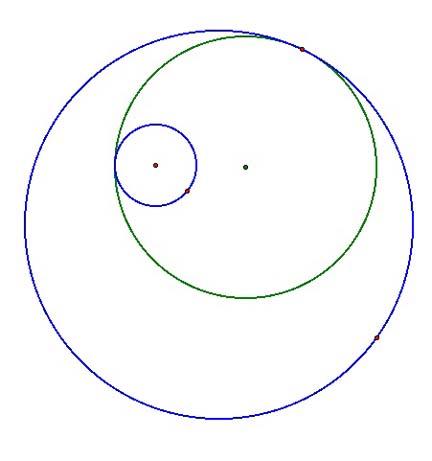 |
If you would like to investigate such triangles, I have created a Geometer's Sketchpad tool that will help you do so. If you would like to construct the circles yourself using GSP, try following the instructions on the EMAT 6680 assignment page.
There are several interesting things that happen when you construct these tangent circles. Firstly, if we move the point of tangency to the outer circle around its circumference, we can create a locus of points for the center of the tangent circle. It turns out, that in either case, the locus of points will be an ellipse. Furthermore, as you move the inner circle closer to the center of the center of the outer circle, the locus starts to look more and more like a circle itself. As you move the inner circle towards the outer circle, the focus begins to look more elliptical.
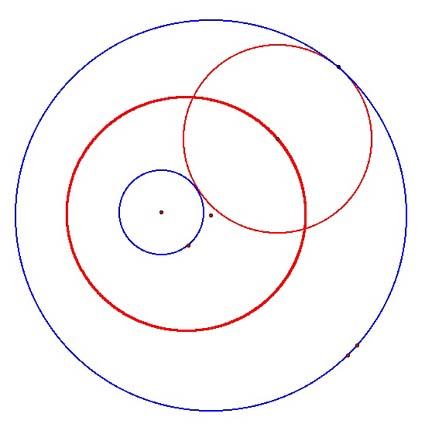 |
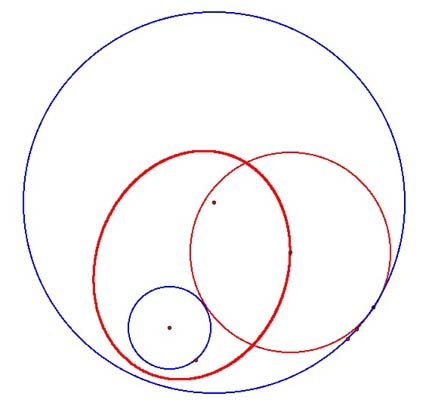 |
One question would be to ask yourself exactly why is this locus an ellipse? In order to solve this mystery, it helps if the construction of the tangent circle is shown in a bit more detail. In order to construct one of tangent circles, first you must construct the two given circles, and choose a point on the outer circle for the point of tangency. These circles will have centers A (circle A) and C (circle C) and the point of tangency will be D.
Using D as a center, you then construct another circle with the same radius as circle A. Call this circle D. Next you will construct line CD. This line will intersect circle D two places, points E and F.
To construct the red tangent circle, you then construct line segment AE and its perpendicular bisector. This line intersects line CD at point B. Notice that triangle ABE is an isosceles triangle and B will be the center of the tangent circle with radius BD.
To construct the green tangent circle, the process is identical except that you use construct line segment BF and its perpendicular bisector to find the isosceles triangle ABF. The below diagrams may help with these explanations.
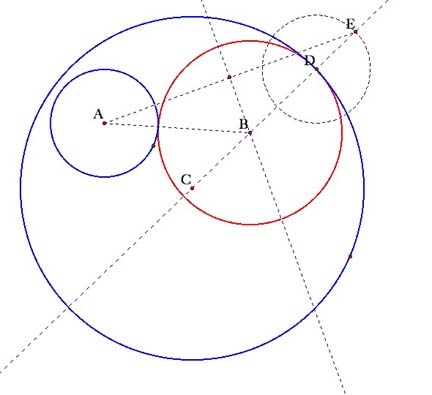 |
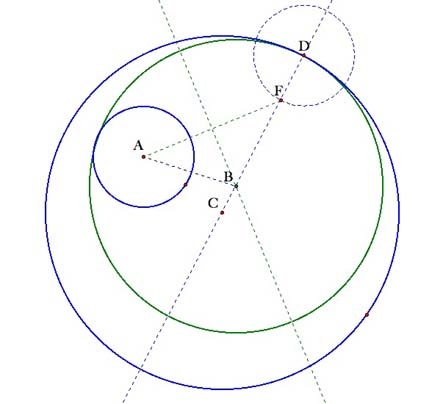 |
Since the definition of an ellipse is the set of all points where the distance from two foci is constant, we can use the above diagrams to show that the locus of point B will in fact be an ellipse. Notice that in the case of the red tangent circle, AB + BC = sum of the radii of the two given circles which will be constant. (Take the portion of AB that starts at the boundary of circle A and see that if this is added to CB, the line will extend to D). In the case of the green tangent circle, AB + CB = difference of the radii of the twho given circles which is constant. (Since AB = BF, CB = (radius of circle C) - (radius of circle A) - AB. Hence, AB + CB = (radius of circle C) - (radius of circle A)).
Now I would like to discuss what happens to these loci if circle A intersects circle C or if circle A lies on the exterior of circle C. In the case of the intersecting circles, it turns out that the center of the red tangent circle will still have as its locus an ellipse. This again can be proven using the trangle formed during the construction of the tangent circle. The GSP file of this situation is available for you to play with, but a visual of the proof and construction is provided below.
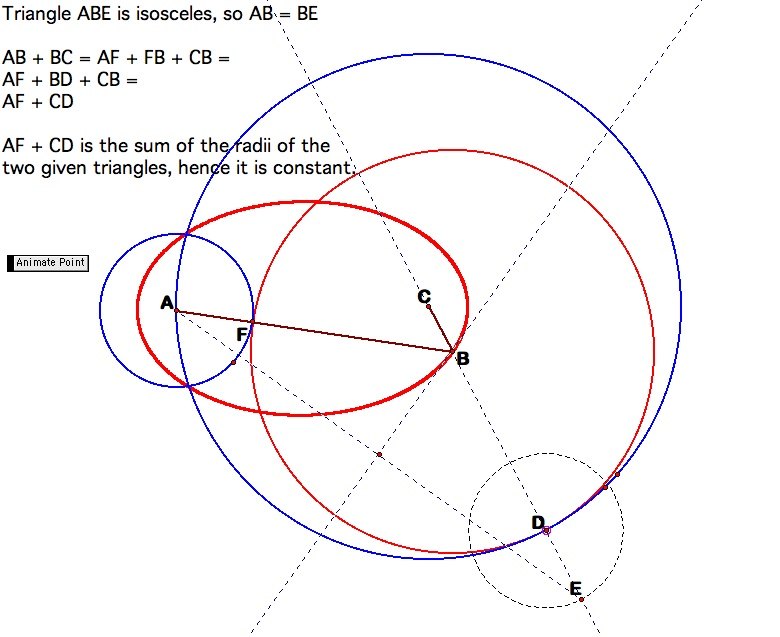
What is more interesting that this case is the case of the green tangent circle in the intersecting situation. As it turns out, the locus of points for the center of the tangent circle no longer is an ellipse. In this case, the locus becomes a hyperbola! Again, the GSP file can be used for your own investigation, but see the proof and construction below. Notice that line segment CF is the difference of the radii of the two given circles, and is hence constant. Therefore, the difference of the distances of the points on the locus and the two foci is constant, hence making the locus a hyperbola.

Next I will consider these two cases when the given circles are disjoint. It turns out that in both of these cases, the locus for the center of the tangent circle will be a hyperbola. With the red tangent circle, the hyperbola will be more curved than with the green tangent circle, where the hyperbola is more steep. The pictures below will help show the proofs for these ideas.

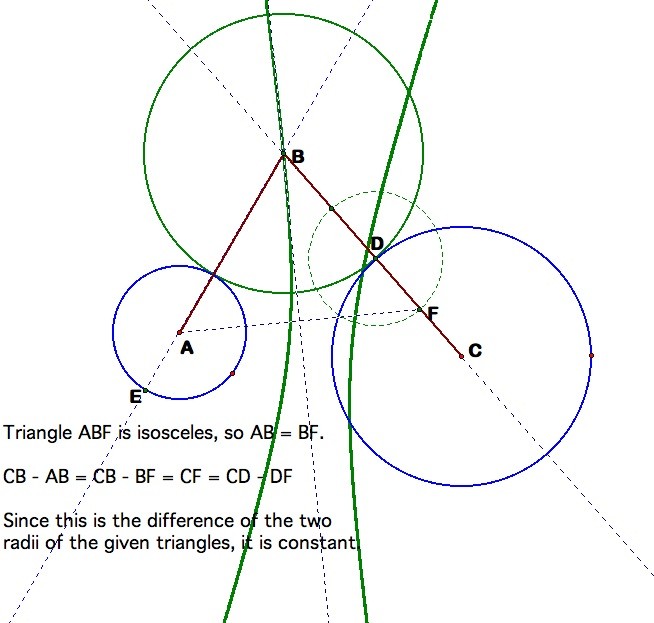
It is interesting to notice that in all the proofs above for the locus of points for the center of the tangent circles, that a similar theme occurs throughout. That is to say, the proofs concerning the tangent circle that is "between" the two given circles, i.e. the red tangent circle, always deal with the sum of the two radii of the given circles. Furthermore, the proofs concerning the tangent circle that "encloses" one of the given circles, i.e. the green tangent circle, always use the difference ofthe two radii of the given circles. This happens because of the way that the circles are constructed. When the red tangent circle was constructed, the triangle formed used as one of its vertices a point of intersection that was beyond the borders of the given circles. Thus it makes sense to use the sum of the two radii. Furthermore, when the green tangen circle was constructed, the triangle formed used as one of its vertices a point of intersection that was within the borders of the given circle. Hence it makes sense to use the difference of the two radii.
One final extension occurs when a line and a circle are used instead of two circles. So you would want to create a circle that is tangent to both a given line and a given circle. In this case, it is again possible to create two such tangent circles and observe the behavior of their centers. Something very interesting happens in this case. The two loci seem to become two halves of two parabolas! An interesting exercise would be to try to prove why this happens, so here is a GSP file with the constructions for you to give it a whirl!
